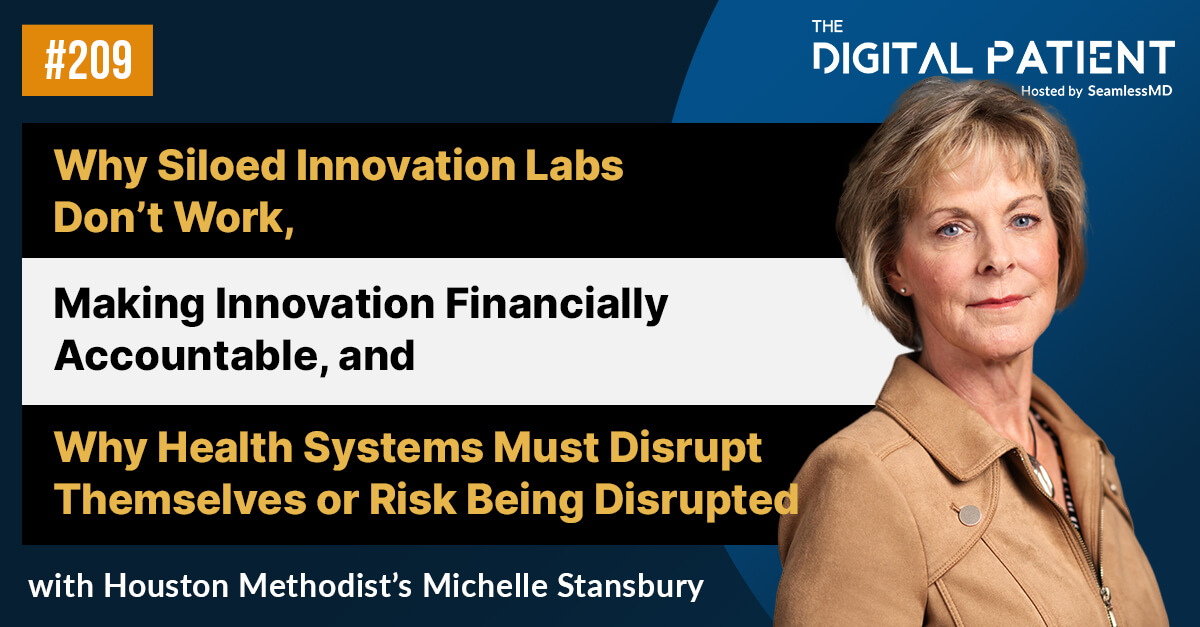Subscribe on: RSS | SPOTIFY | APPLE PODCAST | GOOGLE | BREAKER | ANCHOR
Video:
In this episode of the SeamlessMD Podcast, Dr. Joshua Liu, Co-founder & CEO at SeamlessMD, and marketing colleague, Alan Sardana, share their thoughts on whether it's better to build or buy a digital patient engagement solution. See the full show notes below for details.
Guest(s): Dr. Joshua Liu (@joshuapliu), Co-founder & CEO at SeamlessMD
Episode 36 – Show notes:
[1:03] Definition for Digital Patient Engagement:
Technology that addresses the aspect of the patient journey where provided instructions are difficult to follow (e.g. complicated discharge instructions); helps clinical teams consistently keep tabs on patient progress pre and post-treatment.
Digital Patient Engagement technology engages, connects with, and monitors patients throughout their medical journey; utilizing features such as recurring reminders for procedural steps (e.g. take your medication), educational videos on recovery for a specific treatment, and empowering patient progress-tracking (e.g. pain levels, wound healing progress, etc.) while providing clinical teams with alerts and updates when necessary;
[3:19] Pro #1 (Build): Ownership – The technology is yours so you hold all of the rewards (and risk), which could include potential licensing opportunities;
[3:50] Pro #2 (Build): Lowerprice tag (potentially) – If your organization is low on cash, leveraging the staffedIT department to build a platform could be attractive, bear in mind significantdevelopment costs in time and labor;
[4:54] Pro #2 (Build): Youdon’t have to rely on a third party – You don’t have to shop around for a goodvendor, you don’t need to worry about the vendor going out of business, you alsohave full control over the direction of the platform which can be advantageous;
[8:09] Con #1 (Build): Time & no guarantee it will work – Your first build will take months and V1 will not be successful (e.g. patient adoption, engagement rates, etc.) and will require testing and iteration to become beneficial, which is a tedious and expensive process that many organizations overlook;
[10:01] Con #2 (Build): It’s not a one-time effort (requires ongoing upkeep & maintenance) – You will basically need to spin off a small company inside your organization to ensure the platform is routinely updated, bugs are squashed, and to provide ongoing support for providers and patients to ensure they get the most value out of the program(s). Patients also require tech-support and staff is required to manage the projects of integrating, implementing & supporting the solution for its lifespan;
[14:09] Con #3 (Build): Youmiss out on best practice learning from other organizations – Patientengagement vendors work with multiple hospitals, and have valuable experience thatcan be used to help avoid pitfalls that first-time developers would otherwiserun into;
[16:52] Con #4 (Build): Short-term failure can stifle innovation – If your V1 build is unsuccessful it can impede future progress and innovation. V1 products are often barebones and not user-friendly, which can lead to poor initial outcomes such as low patient adoption & engagement rates & subsequently the concept of digital patient engagement could be written off as a failure;
[19:51] Pro #1 (Buy): You can start immediately with lower cost and risk – (good) Patient Engagement vendors have experience; out-of-the-box, clinically-validated digital care plans proven to achieve high patient engagement & improved clinical outcomes, proven workflows & strategies to implement patient engagement technology quickly and at scale, and provide on-going support from a team of trusted advisors & service professionals;
[22:36] Pro #2 (Buy): Continuous platform enhancements and maintenance – You get access to new features & digital care plans from a team that is exclusively focused on digital patient engagement 24/7; can derive benefit from platform enhancements and updates informed by data and best practices from across a customer network;
[27:27] Pro #3 (Buy): Patientengagement expertise – The confidence and expertise of the vendor is also vitalto your success in digital patient engagement. For e.g. SeamlessMD has 8+ yearsof expertise in launching and maintaining effective patient engagementtechnology;
[28:04] Pro #4 (Buy): Access to the customer network – Using a vendor solution, you can have a dialogue with and receive information about other healthcare organizations to share best practices, to collaborate, and to develop a better understanding of how to use the technology most effectively;
[29:04] Con #1 (Buy): Youdon’t own the product – Thus you cannot choose every single exact feature; couldfeel underprioritized;
[30:00] Con #2 (Buy): “Potentially more expensive long-term” – If scaling across an entire health system buying a solution could have a bigger price tag upfront, but at the same time as per the discussion, there are many “hidden fees” that come with building your own solution such as constant maintenance, additional ongoing labor needed, as well as all the extra time needed for clinicians and relevant personnel to familiarize and train others on the platform;
[33:56] Why your decisionultimately should be based around your intended outcome (e.g. reducingreadmissions, market differentiation), and your current situation;
[36:51] Why healthcareorganizations should not necessarily be dissuaded from developing their owndigital patient engagement platforms, but instead be more mindful and aware of opportunitiesthat exist and the additional benefits that vendors can offer;
.svg)









.png)
